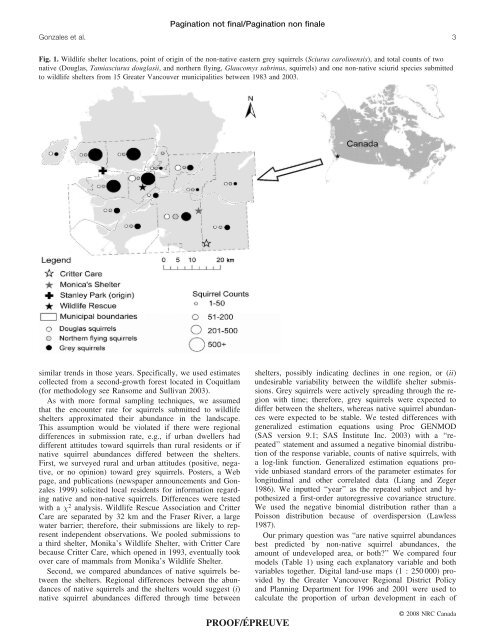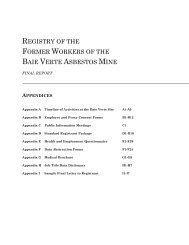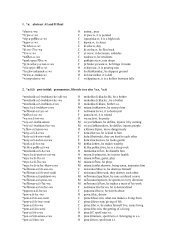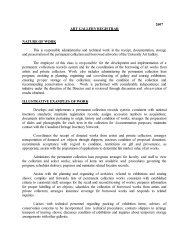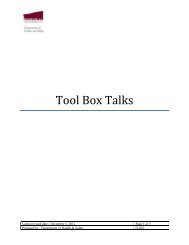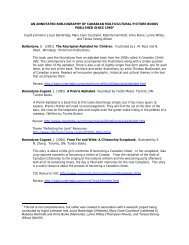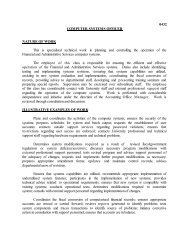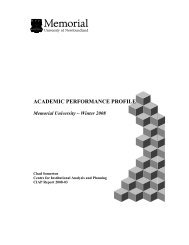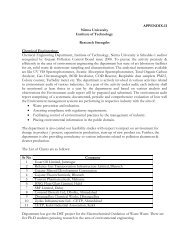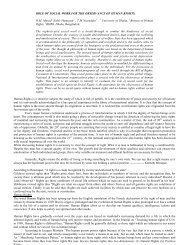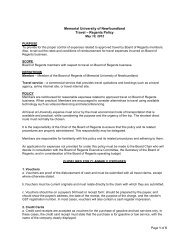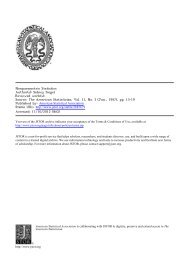Positive relationship between non-native and native squirrels in an ...
Positive relationship between non-native and native squirrels in an ...
Positive relationship between non-native and native squirrels in an ...
Create successful ePaper yourself
Turn your PDF publications into a flip-book with our unique Google optimized e-Paper software.
Pag<strong>in</strong>ation not f<strong>in</strong>al/Pag<strong>in</strong>ation <strong>non</strong> f<strong>in</strong>ale<br />
Gonzales et al. 3<br />
Fig. 1. Wildlife shelter locations, po<strong>in</strong>t of orig<strong>in</strong> of the <strong>non</strong>-<strong>native</strong> eastern grey <strong>squirrels</strong> (Sciurus carol<strong>in</strong>ensis), <strong><strong>an</strong>d</strong> total counts of two<br />
<strong>native</strong> (Douglas, Tamiasciurus douglasii, <strong><strong>an</strong>d</strong> northern fly<strong>in</strong>g, Glaucomys sabr<strong>in</strong>us, <strong>squirrels</strong>) <strong><strong>an</strong>d</strong> one <strong>non</strong>-<strong>native</strong> sciurid species submitted<br />
to wildlife shelters from 15 Greater V<strong>an</strong>couver municipalities <strong>between</strong> 1983 <strong><strong>an</strong>d</strong> 2003.<br />
similar trends <strong>in</strong> those years. Specifically, we used estimates<br />
collected from a second-growth forest located <strong>in</strong> Coquitlam<br />
(for methodology see R<strong>an</strong>some <strong><strong>an</strong>d</strong> Sulliv<strong>an</strong> 2003).<br />
As with more formal sampl<strong>in</strong>g techniques, we assumed<br />
that the encounter rate for <strong>squirrels</strong> submitted to wildlife<br />
shelters approximated their abund<strong>an</strong>ce <strong>in</strong> the l<strong><strong>an</strong>d</strong>scape.<br />
This assumption would be violated if there were regional<br />
differences <strong>in</strong> submission rate, e.g., if urb<strong>an</strong> dwellers had<br />
different attitudes toward <strong>squirrels</strong> th<strong>an</strong> rural residents or if<br />
<strong>native</strong> squirrel abund<strong>an</strong>ces differed <strong>between</strong> the shelters.<br />
First, we surveyed rural <strong><strong>an</strong>d</strong> urb<strong>an</strong> attitudes (positive, negative,<br />
or no op<strong>in</strong>ion) toward grey <strong>squirrels</strong>. Posters, a Web<br />
page, <strong><strong>an</strong>d</strong> publications (newspaper <strong>an</strong>nouncements <strong><strong>an</strong>d</strong> Gonzales<br />
1999) solicited local residents for <strong>in</strong>formation regard<strong>in</strong>g<br />
<strong>native</strong> <strong><strong>an</strong>d</strong> <strong>non</strong>-<strong>native</strong> <strong>squirrels</strong>. Differences were tested<br />
with a 2 <strong>an</strong>alysis. Wildlife Rescue Association <strong><strong>an</strong>d</strong> Critter<br />
Care are separated by 32 km <strong><strong>an</strong>d</strong> the Fraser River, a large<br />
water barrier; therefore, their submissions are likely to represent<br />
<strong>in</strong>dependent observations. We pooled submissions to<br />
a third shelter, Monika’s Wildlife Shelter, with Critter Care<br />
because Critter Care, which opened <strong>in</strong> 1993, eventually took<br />
over care of mammals from Monika’s Wildlife Shelter.<br />
Second, we compared abund<strong>an</strong>ces of <strong>native</strong> <strong>squirrels</strong> <strong>between</strong><br />
the shelters. Regional differences <strong>between</strong> the abund<strong>an</strong>ces<br />
of <strong>native</strong> <strong>squirrels</strong> <strong><strong>an</strong>d</strong> the shelters would suggest (i)<br />
<strong>native</strong> squirrel abund<strong>an</strong>ces differed through time <strong>between</strong><br />
shelters, possibly <strong>in</strong>dicat<strong>in</strong>g decl<strong>in</strong>es <strong>in</strong> one region, or (ii)<br />
undesirable variability <strong>between</strong> the wildlife shelter submissions.<br />
Grey <strong>squirrels</strong> were actively spread<strong>in</strong>g through the region<br />
with time; therefore, grey <strong>squirrels</strong> were expected to<br />
differ <strong>between</strong> the shelters, whereas <strong>native</strong> squirrel abund<strong>an</strong>ces<br />
were expected to be stable. We tested differences with<br />
generalized estimation equations us<strong>in</strong>g Proc GENMOD<br />
(SAS version 9.1; SAS Institute Inc. 2003) with a ‘‘repeated’’<br />
statement <strong><strong>an</strong>d</strong> assumed a negative b<strong>in</strong>omial distribution<br />
of the response variable, counts of <strong>native</strong> <strong>squirrels</strong>, with<br />
a log-l<strong>in</strong>k function. Generalized estimation equations provide<br />
unbiased st<strong><strong>an</strong>d</strong>ard errors of the parameter estimates for<br />
longitud<strong>in</strong>al <strong><strong>an</strong>d</strong> other correlated data (Li<strong>an</strong>g <strong><strong>an</strong>d</strong> Zeger<br />
1986). We <strong>in</strong>putted ‘‘year’’ as the repeated subject <strong><strong>an</strong>d</strong> hypothesized<br />
a first-order autoregressive covari<strong>an</strong>ce structure.<br />
We used the negative b<strong>in</strong>omial distribution rather th<strong>an</strong> a<br />
Poisson distribution because of overdispersion (Lawless<br />
1987).<br />
Our primary question was ‘‘are <strong>native</strong> squirrel abund<strong>an</strong>ces<br />
best predicted by <strong>non</strong>-<strong>native</strong> squirrel abund<strong>an</strong>ces, the<br />
amount of undeveloped area, or both?’’ We compared four<br />
models (Table 1) us<strong>in</strong>g each expl<strong>an</strong>atory variable <strong><strong>an</strong>d</strong> both<br />
variables together. Digital l<strong><strong>an</strong>d</strong>-use maps (1 : 250 000) provided<br />
by the Greater V<strong>an</strong>couver Regional District Policy<br />
<strong><strong>an</strong>d</strong> Pl<strong>an</strong>n<strong>in</strong>g Department for 1996 <strong><strong>an</strong>d</strong> 2001 were used to<br />
calculate the proportion of urb<strong>an</strong> development <strong>in</strong> each of<br />
PROOF/ÉPREUVE<br />
# 2008 NRC C<strong>an</strong>ada


